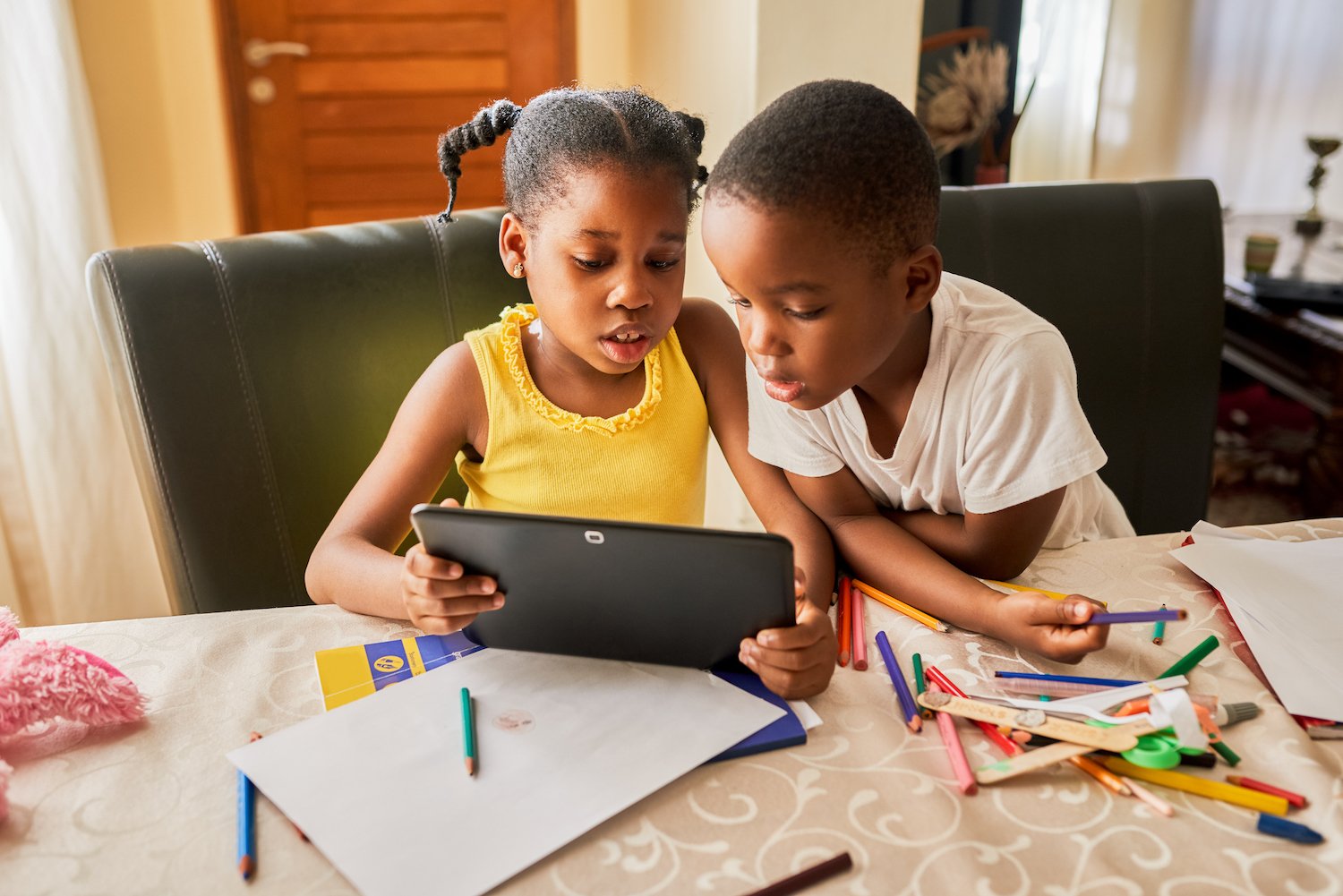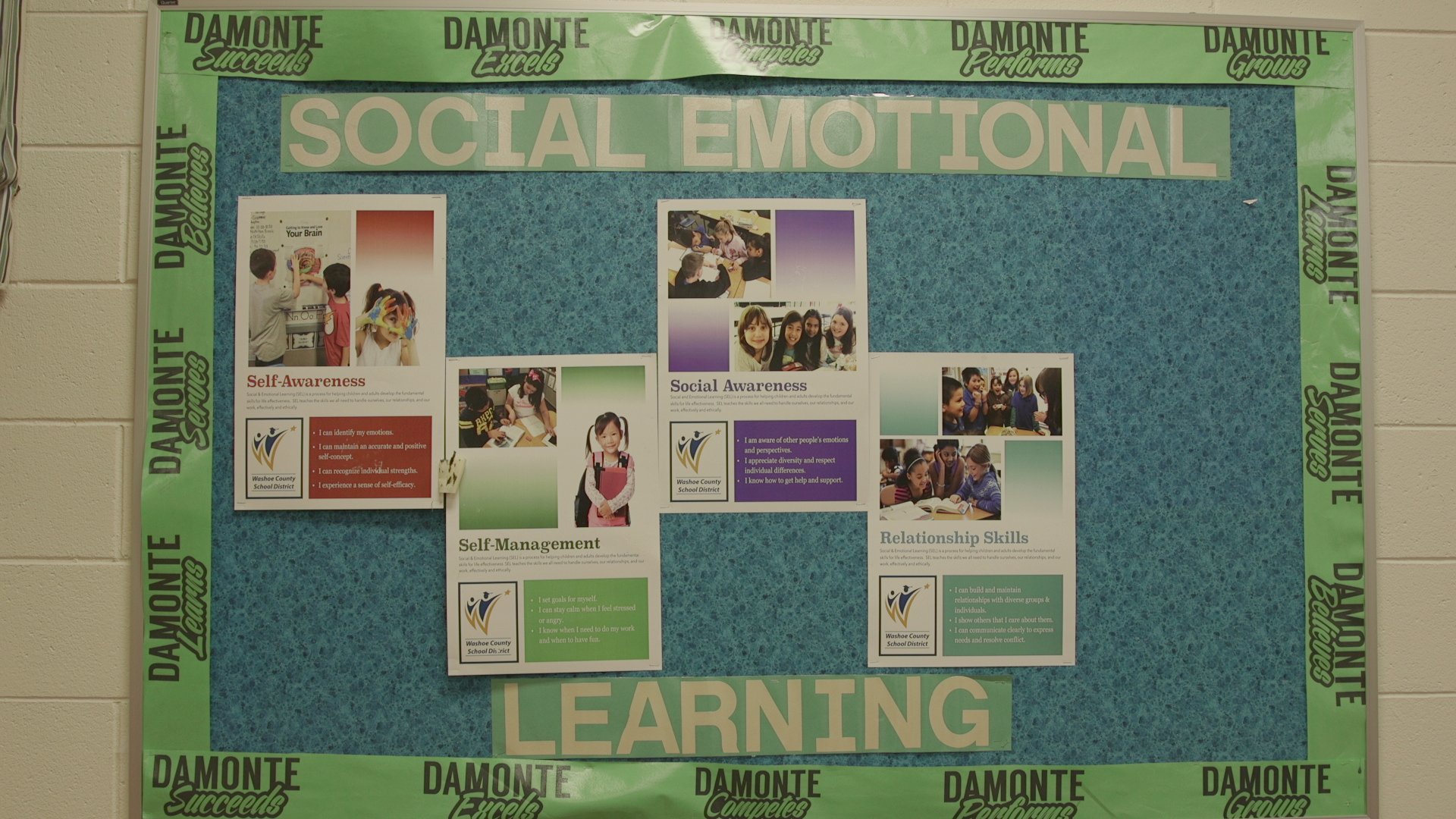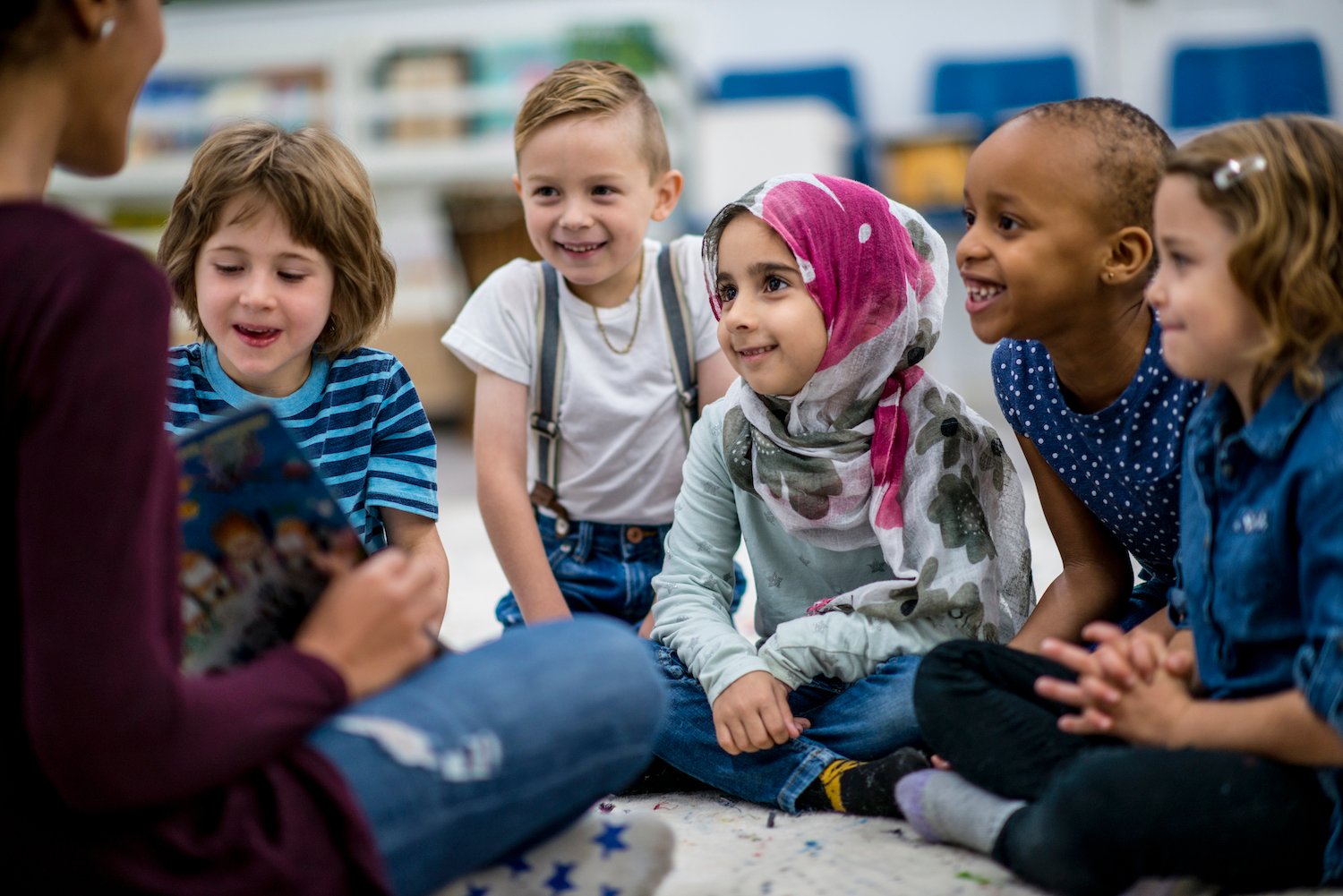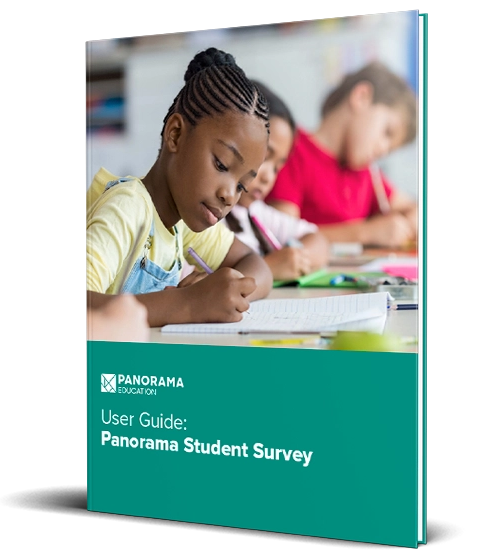Over the past two decades, a consensus has emerged among educators, researchers, policymakers, and caregivers that social and emotional skills are important for youth (and adult) development.
The field of social-emotional learning (SEL) has rapidly evolved and expanded—resulting in an influx of approaches, resources, research, and tools for measuring, understanding, and developing students' social, emotional, and interpersonal skills.
Social-emotional learning curriculum providers specialize in delivering comprehensive, evidence-based programs that produce positive social, emotional, and academic outcomes for students.
But with so many different options to choose from, it can be overwhelming to know which curriculum providers or programs to select. What are the different types of SEL curricula, and what grade levels are they most appropriate for? What is important to consider when evaluating programs?
In this post, we’ll share an overview of the landscape of social-emotional learning programs. including what criteria to consider when evaluating curriculum providers and a list of 20+ leading SEL programs and tools for K-12.
Download Now: Panorama's Social-Emotional Learning Assessment
I. List of SEL Curriculum Providers and Programs
II. Why Should SEL Be a Strategic Focus in My District or School?
III. What Should I Consider When Evaluating SEL Programs?
IV. How Does Panorama Partner With SEL Curriculum Providers?
20+ Leading SEL Curriculum Providers and Programs
Lesson-Based, In-School or After School SEL Programs
|
Provider Name |
Grade Levels |
Evidence of Effectiveness |
Area(s) of Focus |
Panorama Playbook Partner? |
|
K-8 |
Multiple randomized control trials and quasi-experimental studies |
Building empathy; setting classroom norms; fostering community; positive goal setting |
No |
|
|
K-12 |
Inclusion of evidence-based implementation strategies; inclusion of evidence-based best practices |
Whole child development (self-awareness, self-management, social awareness, relationship skills, responsible decision-making); character development (patience, kindness, honesty, selflessness, humility, forgiveness, commitment) |
Yes |
|
|
EduMotion |
K-12 |
Explicit evidence-based SEL instruction |
Age-differentiated SEL lessons aligned to CASEL’s framework; movement-based activities; culturally responsive pedagogy; family engagement |
Yes |
|
6-12 |
Inclusion of evidence-based best practices; qualitative case studies |
Leadership and character development; image-based curriculum; critical thinking skills, college and career readiness |
Yes |
|
|
K-12 |
Randomized control trials and qualitative interview studies |
Drug and bullying prevention; character education; service learning; positive relationships |
No |
|
|
K-12 |
Inclusion of evidence-based best practices |
Interactive video- and movement-based SEL; relationship building; culture of safety and support; student engagement |
Yes |
|
|
K-5 |
One quasi-experimental study; one non-experimental study |
Emotion labeling and regulation; positive school culture and climate; integration into literacy; problem solving skills |
Yes |
|
|
K-6 |
Multiple randomized control studies |
Reducing aggression and behavior problems through social-emotional development; self-control; goal setting; empathy; organizational and study skills |
No |
|
|
K-12 |
Inclusion of evidence-based best practices |
Integrating SEL into ELA; personalized learning; game-based learning |
Yes |
|
|
K-12 |
Multiple randomized control trials |
Self-concept; mind-body connection; self-honesty; continual self-improvement; conflict resolution |
Yes |
|
|
K-5 |
Inclusion of research-based and evidence-based best practices |
Creating a culture of caring; music-based SEL; personalized learning; positive relationships between teachers and students |
Yes |
|
|
K-12 |
One independent research study and ongoing assessments. Research-based and evidence-based best practices throughout curriculum. |
Exclusive partnership with the Attachment and Trauma Network, who vet all written and digital materials as trauma-informed. Digital access includes at-home student versions for virtual use on any device. Curriculum includes hundreds of original poems and songs. |
Yes |
|
|
K-12 |
One randomized control trial and one quasi-experimental study |
Emotional intelligence; labeling emotions; expressing emotions appropriately; regulating emotions effectively |
No |
|
|
K-8 |
Multiple randomized control trials and quasi-experimental studies |
Curriculum delivering skills to help students build SEL competencies; game-based learning; emotion regulation; problem-solving skills; responsible decision-making; music- and story-based activities |
Yes |
|
|
K-5 |
Multiple quasi-experimental and randomized control trials |
After school program; healthy relationships; positive behavior; self-awareness; social awareness; self-management; implicit and explicit teaching by weaving SEL into the program time |
Yes |
Non-Curricular Approaches to SEL
|
Provider Name |
Grade Levels |
Evidence of Effectiveness |
Area(s) of Focus |
Panorama Playbook Partner |
|
K-3 |
Randomized control study |
Social-emotional learning through play; game-based learning; personalized learning; creativity through play; responsible decision-making skills |
Yes |
|
|
K-12 |
Multiple experimental studies |
Organizational approach to schoolwide, systemic SEL; classroom management; teaching practices to promote SEL, resiliency, and self-regulation; trauma-informed care |
Yes |
|
|
K-12 |
Formatted on an evidence-based protocol (MBSR); multiple randomized control trials |
Daily mindfulness practice; emotion regulation; stress management; compassion; social-emotional competencies |
Yes |
|
|
K-12 |
Multiple randomized control trials |
Physical wellness; social and emotional growth; play-based learning; integrating SEL into recess; health and fitness |
Yes |
|
|
K-8 |
Multiple quasi-experimental and randomized control trials |
Interactive modeling and learning structures; classroom management; educational environment; social and emotional competencies; academic mindset; perseverance |
No |
Adult SEL Programs and Tools
|
Provider Name |
Grade Levels |
Evidence of Effectiveness |
Area(s) of Focus |
Panorama Playbook Partner |
|
Adults |
Multiple randomized trials |
Cultivating awareness and resilience in educators; social and emotional functioning; mindfulness; mental well-being; nurturing healthy, caring school communities |
Yes |
|
|
Adults |
Format rooted in evidence-based theories of positive psychology and expressive arts therapy |
Visioning Labs series are designed to emotionally sustain and support staff. Enrichment Workshops enhance buy-in for SEL and implementation of Move This World's SEL programs |
Yes |
Why Should Social-Emotional Learning Be a Strategic Focus in My District or School?
According to a 2020 update from CASEL (the Collaborative for Academic, Social, and Emotional Learning), the definition of SEL is as follows:
|
Social and emotional learning (SEL) is an integral part of education and human development. SEL is the process through which all young people and adults acquire and apply the knowledge, skills, and attitudes to develop healthy identities, manage emotions and achieve personal and collective goals, feel and show empathy for others, establish and maintain supportive relationships, and make responsible and caring decisions. SEL advances educational equity and excellence through authentic school-family-community partnerships to establish learning environments and experiences that feature trusting and collaborative relationships, rigorous and meaningful curriculum and instruction, and ongoing evaluation. SEL can help address various forms of inequity and empower young people and adults to co-create thriving schools and contribute to safe, healthy, and just communities. |
Social-emotional learning (SEL) describes the mindsets, skills, attitudes, and feelings that help students succeed in school, career, and life. At its core, SEL focuses on students’ fundamental needs for motivation, social connectedness, and self-regulation as prerequisites for learning. Educators may also refer to SEL as “non-cognitive skills,” "interpersonal skills," “soft skills,” “21st century skills,” “character strengths,” and “whole child development.”
Social-emotional learning is an important part of a well-rounded education, and research shows that it is linked to academic success:
- A 2017 meta-analysis from CASEL shows that investment in SEL has led to improved classroom behavior, better stress management, and 13 percent gains in academics.
- A 2019 report from the Aspen Institute, “From a Nation at Risk to a Nation at Hope,” compiles evidence confirming that supporting students’ social, emotional, and cognitive development relates positively to traditional measures like attendance, grades, test scores, graduation rates, college and career readiness, and overall well-being.
The research is also promising when it comes to SEL curricula and programs:
- Findings from 213 controlled studies indicate high-quality, evidence-based social and emotional learning programs produce a wide variety of positive outcomes for students, from improved attitudes to decreased behavioral issues to increased academic performance (Durlak et al., 2011).
- SEL programs are proven to be one of the most successful interventions that districts and schools can implement in terms of promoting positive development and academic achievement in K-12 student populations.
- A review of six SEL interventions in evidence-based curricula showed that for every $1 invested in SEL programming, there was an economic return of $11.
Social-Emotional Learning: From Assessment to Action
Effective SEL programs support the development of core competencies, including but not limited to: Self-Awareness, Self-Management, Social Awareness, Relationship Skills, and Responsible Decision-Making. Some are more focused on developing explicit SEL skills—such as emotion regulation—while others are designed to develop certain mindsets or character traits.
When paired with a valid and reliable assessment to measure students’ social-emotional learning skills, SEL curricula can help districts understand and respond to student needs while measuring the impact of investments. Using data-driven insights to implement (and continuously improve) SEL curriculum is correlated to increases in perceptions of school climate, sense of belonging, and self-efficacy in students.
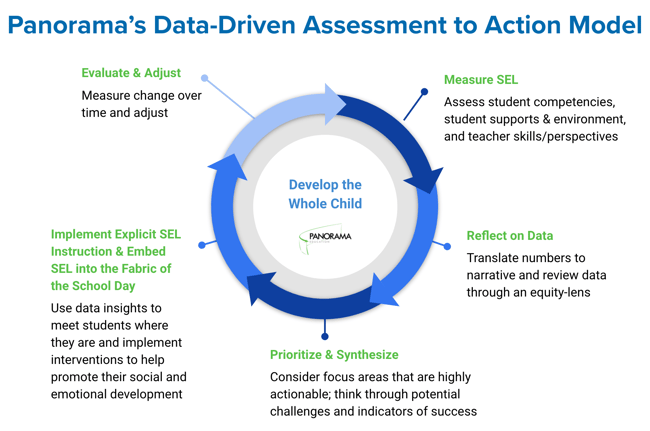 [Source: Panorama Education]
[Source: Panorama Education]
What Should I Consider When Evaluating SEL Programs?
There is no one-size-fits-all approach to social-emotional learning. Each classroom, school, after school program, and district is unique—as are the needs of each student in every school community. An elementary school in a suburb of Phoenix, Arizona will likely approach a search for an SEL program very differently from a middle school in New York City.
Approaches and delivery methods for SEL curricula can vary widely. Some programs focus on character development, while others focus on building core competencies such as Social Awareness and Self-Management. Some are game oriented, while others are movement based or project based. Some offer curriculum for K-12, while others are only age-appropriate for middle school and high school students. Some are flexible and customizable, while others are quite uniform. And, with the shift to hybrid and remote learning models during the COVID-19 pandemic, many SEL curriculum providers have adapted their content for virtual delivery.
With this in mind, it can be daunting for decision-makers to understand the differences among various curriculum providers.
Fortunately, research from CASEL and the EASEL Lab at Harvard University provide a clear understanding of the factors that can make SEL programs more effective than others. The following guidelines can help you make an informed choice about which SEL programs are the best fit for your community of learners.
- Understand which programs are "research-based" versus "evidence-based." The terms “research-based” and “evidence-based” are often used interchangeably to describe SEL programs. However, there is a significant difference. A curriculum that is “research-based” is one that is grounded in theories and empirical evidence. An “evidence-based” program has efficacy to back up claims of positive impacts on student behavior and/or academic performance. Evidence-based programs have been studied by researchers who were not involved in the creation of the content, and cannot profit from the outcomes of their research.
- Recognize the importance of context and environments. SEL programming is about more than just targeting specific SEL skills. Effective programs must also acknowledge and address the broader community context in which children live and learn. Do curriculum providers take into account the environments and contexts in which children are living, learning, and growing when designing their lesson plans? How are caregivers and community-serving organizations involved in programming?
- Look for programs with a variety of instructional methods. Effective SEL programs acknowledge that each student has a different learning style, and provide students with multiple opportunities for practicing SEL skills. Common instructional practices found in leading social-emotional learning programs include: didactic instruction, storytelling, SEL handouts or printouts, writing exercises, small group SEL lessons, culturally responsive lesson plans, drawing activities, song and dance, video-based exercises, skill practice, role play, and kinesthetic activities.
- Consider implementation supports. When learning about an organization's approach to SEL programming, it’s important to understand what types of supports they offer in terms of initial training, ongoing support, and professional development to ensure that their curriculum is implemented with fidelity.
- Identify programs that target a key set of social-emotional skills across multiple domains, as well as programs that support adult competencies. Within a social-emotional learning curriculum, are specific skills targeted (in a developmentally-appropriate way) across multiple domains of development (e.g., executive functioning skills, social and interpersonal skills, and emotion regulation)? In addition, look for SEL programs that include practices and resources for building adult capacity along with pedagogical guidance.
How Does Panorama Partner With SEL Curriculum Providers?
Panorama Education partners with K-12 school and districts across the country to collect and analyze data about social-emotional learning, school climate, family engagement, and more.
Districts and schools that use Panorama's SEL measurement platform have access to evidence-based content and curriculum from leading social-emotional learning programs in Panorama's Playbook.
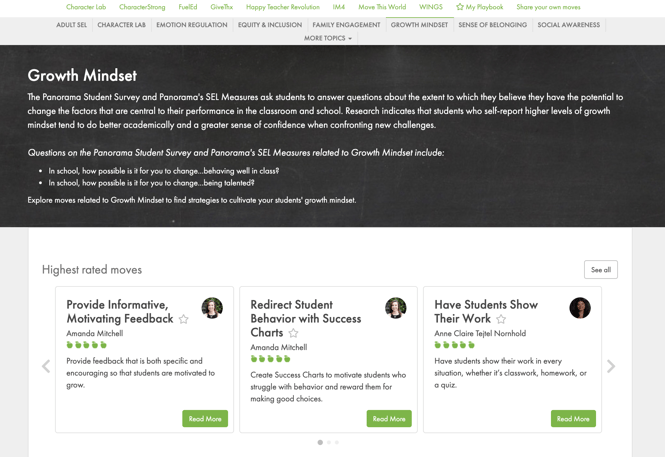
Playbook is an online professional learning library that equips teachers and school leaders with strategies and interventions for fostering a positive school culture and embedding SEL in K-12 classrooms. Every resource in Playbook aligns to topics on Panorama's SEL assessment so that educators can seamlessly shift from understanding data to implementing social-emotional learning activities in their classrooms and schools.
See the full list of Panorama's SEL Curriculum Partners.
Additional Resources
- CASEL's Program Guides
- How to Select the Right SEL Program for Your Class (via National University)
- Navigating Social and Emotional Learning Programs From the Inside Out (via The Wallace Foundation)
- Taxonomy Project (via EASEL Lab at Harvard University)
- WEBINAR: Evaluating and Selecting SEL Programs (via Move This World)


